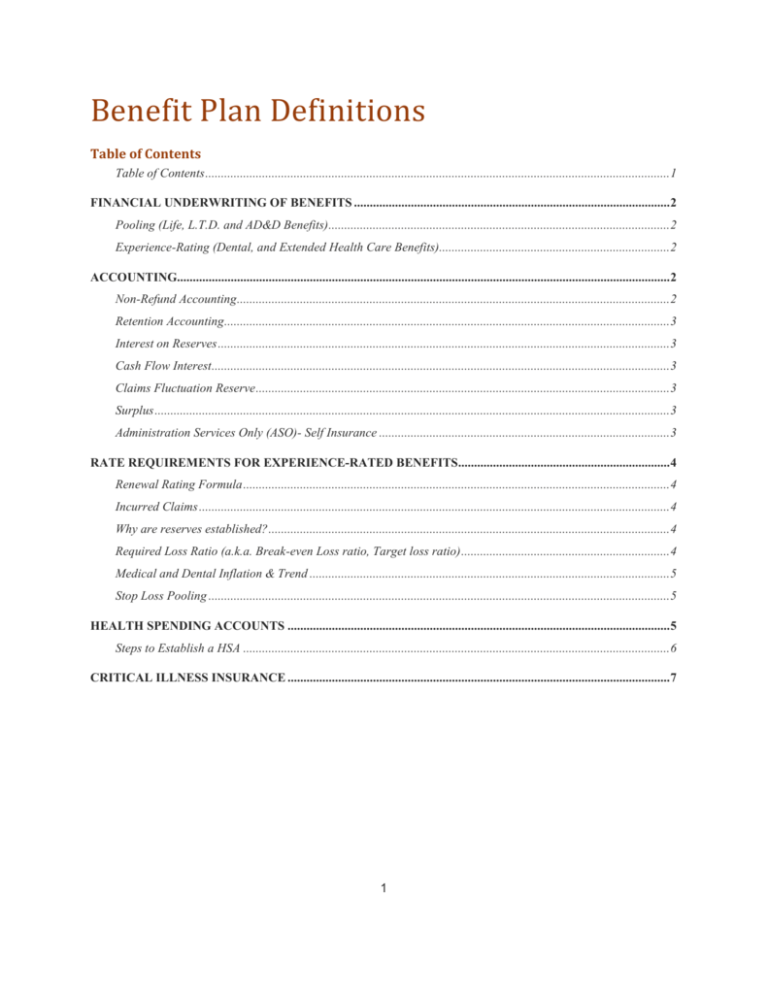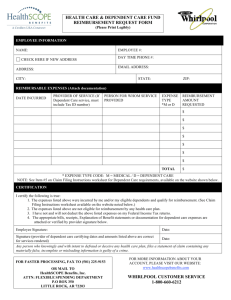Understanding Benefits - Accurate Design Benefits
advertisement

Benefit Plan Definitions Table of Contents Table of Contents ................................................................................................................................................... 1 FINANCIAL UNDERWRITING OF BENEFITS .................................................................................................... 2 Pooling (Life, L.T.D. and AD&D Benefits) ............................................................................................................ 2 Experience-Rating (Dental, and Extended Health Care Benefits)......................................................................... 2 ACCOUNTING............................................................................................................................................................ 2 Non-Refund Accounting ......................................................................................................................................... 2 Retention Accounting ............................................................................................................................................. 3 Interest on Reserves ............................................................................................................................................... 3 Cash Flow Interest ................................................................................................................................................. 3 Claims Fluctuation Reserve ................................................................................................................................... 3 Surplus ................................................................................................................................................................... 3 Administration Services Only (ASO)- Self Insurance ............................................................................................ 3 RATE REQUIREMENTS FOR EXPERIENCE-RATED BENEFITS................................................................... 4 Renewal Rating Formula ....................................................................................................................................... 4 Incurred Claims ..................................................................................................................................................... 4 Why are reserves established? ............................................................................................................................... 4 Required Loss Ratio (a.k.a. Break-even Loss ratio, Target loss ratio) .................................................................. 4 Medical and Dental Inflation & Trend .................................................................................................................. 5 Stop Loss Pooling .................................................................................................................................................. 5 HEALTH SPENDING ACCOUNTS ......................................................................................................................... 5 Steps to Establish a HSA ....................................................................................................................................... 6 CRITICAL ILLNESS INSURANCE ......................................................................................................................... 7 1 FINANCIAL UNDERWRITING OF BENEFITS Pooling (Life, L.T.D. and AD&D Benefits) Group Life, Accidental Death and Dismemberment and Long Term Disability benefits are unpredictable. They are characterized by a low incidence of claim, accompanied by a high claim level compared to the required premium. The insurer calculates the rate structure of Spec Furniture based on the following: (i) Pool Factor - takes into account the overall financial results obtained by the insurance company in its book of business for each line of benefit. If the level of claims and administrative charges within the 'pool' was in excess of the premiums received, then the insurer would raise rates for all the client companies. This could occur even though the experience of some of these clients was favorable. (ii) Demographic Factor - refers to the distribution changes in your particular group for: Weighted average age - as the average age rises, premium costs rise Female/male ratio - Life insurance costs are higher for males and LTD costs are higher for females (iii) Occupational characteristics – Ex. Heavy Labour industries represent a higher risk. Premiums are based on employee demographics and the financial success of your carrier's "pool". Rate changes at renewal may occur because of variations in the insurer's basic rate table and discount factors. Experience-Rating (Dental, and Extended Health Care Benefits) The renewal rating is based on the financial results generated by your own employee group for a given benefit. All claims incurred during a policy year are charged directly against the premium applicable to that year. The Dental and Health coverage are fully experience-rated because the frequency and amounts of the claim payments are much more predictable as compared to the pooled benefits. ACCOUNTING There are generally three funding arrangements which may be entered into with a carrier. These funding mechanisms will produce different risks and expenses for the client company. 1. Non-Refund Accounting 2. Retention Accounting 3. Administrative Services Only Non-Refund Accounting The insurer establishes a rate for your particular group based on prior history of utilization. At the renewal date, any losses are absorbed by the insurer as are any excess premiums. The following year's rates are then adjusted to reflect the previous three years of utilization. This provides the opportunity to average the claims experience over a number of years allowing for a more stable rate structure from one year to the next. However, when forecasting the renewal rates, the insurer adds their expenses and anticipated inflation for the coming year. Since the insurer does not carry forward losses to future years and they do not reimburse the client for excess premium, their objective is to generate sufficient premium to create surplus. With a new insurer, Dental and Health Care claims would be lower in the first year given the same level of claims activity as the prior year. The outgoing carrier continues to be liable for expenses open before the date of cancellation. Insurers hold a buffer against this contingency which is called an "Open and Unreported" claims reserve. This generally causes a claims reporting lag of up to three months for the incoming insurer. During this period, the new insurer should be able to establish their own reserves for incurred but unreported claims. Clients and Insurers have long debated the amount of money required for this reserve. Employees no longer hold back claims to the same degree, because the value of each claim today is double what it was 15 years ago. To recognize this trend most insurers have lowered their reserve requirements. Retention Accounting The rate is stricken for the upcoming year based on last year's claims. It should be noted that premium rates are an estimate of the cost of the benefits only and that year end cost adjustments will depend on the level of paid claims and the insurance carrier's reserves and expense levels. At renewal if total premiums exceeded paid claims, the client would receive a refund. If claims exceed premiums, the client reimburses the insurer for the outstanding deficit at interest. This funding method is seen by carriers as being more volatile and hence they establish an additional side fund called a "Claims Fluctuation Reserve" or "Rate Stabilization Fund". Under Retention agreements, surplus arises when all premiums due plus interest adjustments less all fund deductions exceed the required Claims Reserve level. Any such surplus will first be applied against deficit carried forward, then will be directed to the Claim Fluctuation Reserve (C.F.R.) and the remainder paid as a dividend. Interest on Reserves - The money held in the "Open and Unreported Claims Reserve" is generally owned by the client. Therefore, they are entitled to interest on the amounts of money held in the reserve. Interest also accrues when premiums exceed claims. If claims exceed premiums the client pays interest to the insurer. Cash Flow Interest - At renewal if total premiums exceeded paid claims, the client would receive interest at the T-Bill rate calculated monthly on this excess. If claims exceed premiums, the client reimburses the insurer for the outstanding interest. Claims Fluctuation Reserve - Retention Accounting requires an additional side fund called a C.F.R. or "Rate Stabilization Fund" which is generally established from surplus. (currently set at 20%, See pages 6 & 15 of Financial Letter of Understanding) Surplus - Surplus is generated when (Premiums + Interest) - Fund deductions , exceed the required loss ratio. Surplus is first applied against any deficits which have been carried forward, then is directed to the Claim Fluctuation Reserve and the remainder paid to the client as an "Experience Rated Refund". The essential difference between Non-Refund Accounting and Retention Accounting is that under Retention Accounting, the insurer would "carry forward" losses to subsequent years. Therefore, premiums would rise for both expected utilization and deficit recovery. Administration Services Only (ASO)- Self Insurance A third party (usually an insurer), is employed to adjudicate and pay claims, and to administer the plan. The insurer takes no risks and acts only as a clearing center for claims. The insurer charges a fixed percentage of paid claims to cover their costs for adjudication expenses. The company is responsible for all health and dental eligible claims, plus expenses, up to the pre-defined individual or group pooling level (Stop-Loss). The risk to the administrating insurance company is for the large claims beyond the pooling threshold. There is no requirement for a Claims Fluctuation Reserve nor is there any need to fund an Incurred But Not Reported Reserve. In most cases, 4 weeks of projected claims (based on your prior claims history), plus applicable taxes, are required up front as a 'float’ against claims for a budgeted approach. Third party ASO providers often, incorrectly, identify reserves as the insurers attempt to protect themselves against termination. The intention of the reserve is to account for the future payment of claims which have already been incurred by the employees. This liability is present in both an insured and an ASO plan. Group Benefit contracts, insured or ASO; make a promise to the employee on behalf of the plan sponsor that certain services will be reimbursed as long as the employee is eligible under the plan. At any time, an employee could have some claims which they have not submitted which the plan sponsor has committed to paying. The Incurred But Not Reported reserve (IBNR) makes an estimate of these claims to identify the liability thereby funding these claims in advance. 3 Under an ASO arrangement, an employer is also committing to cover eligible expenses while an employee is covered and this liability still exists with no pre-funding. There are accounting guidelines from the CICA which require employers to identify this liability but there is no requirement or tax-preferred method to pre-fund it. A typical Costing formula under ASO will look like this: Paid Claims + Inflation + Admin Expenses + Stop Loss + Pooling +Premium Taxes = Premiums Changing to ASO will not eliminate inflation/trend factor assumptions. The only way that this would happen is if the adjudication company fixes the cost, frequency and schedule of eligible services as of a certain date. No new drugs or treatment options would be eligible and no changes in price would be covered. The fact is that ASO claims increase at least as much as insured claims and quite often the increase is at a higher rate if there is no financial incentive for the adjudicator to control claims costs. Funding can be set up to directly access your bank account daily or to have premiums paid on a budgeted basis with varying time frames to settle up deficits, depending on the carrier. Self-insurance is a viable option for many clients. Historically, this underwriting method has produced the lowest administrative costs possible because the insurer has no risk. However, cost is only one facet of the plan. You must also decide your tolerance to risk and your ability to absorb experience fluctuations in cash flow. RATE REQUIREMENTS FOR EXPERIENCE-RATED BENEFITS Renewal Rating Formula (Non-Refund Accounting and Retention Accounting) When establishing rates which will produce a premium level adequate to cover expected claims and expenses, most insurers use the following formula. This formula evaluates a group's past experience with allowance for expected future claims & trends. Renewal Rate Adjustment = Incurred Claims x Required Loss Ratio Trend Incurred Claims “Incurred Claims” is the total of paid claims and reserve adjustments. Why are reserves established? As a result of “lag time”, the claim payments do not represent the true liability. In order for an insurance company to determine its liability and project an accurate claims level for the next policy period, it must estimate the amount of claims it will pay as of the renewal date for expenses incurred prior to that date. This estimate is known as the “reserve for incurred but unpaid claims”. Reserves, therefore, are established to cover the following liabilities: Claims incurred up to the last month in the policy year and submitted to the insurance company, but not paid as of that date Claims incurred up the last month in the policy year, but not submitted to the insurance company as of that date. Claims submitted but the claim is still in the course of payment. Required Loss Ratio (a.k.a. Break-even Loss ratio, Target loss ratio) is the percentage of premium that an insurer can return to employees and still make a profit. The following are included in this cost: General Administration Risk (profit) Premium Taxes Commission Claims Handling Expenses (CHE) Medical and Dental Inflation & Trend There is a general increase in the utilization of Extended Health plans. The trend factor consists of more than just price inflation. Trend is also driven by the advances in medical technology and changes in treatment patterns - utilization of the services. The following factors affect the utilization and cost of a Prescription Drug plan. Higher cost of medications New therapies versus established effective therapies Change in patient mix Lack of patient compliance Aging patient population Use of medication versus personal responsibility for wellness Shorter hospital confinement Insufficient use of generic equivalents Drugs instead of surgery or hospitalization Pharmacist professional fees Higher utilization of medications Advertising direct to consumer Stop Loss Pooling What is Stop Loss Pooling? Pooling is an insurance strategy used to reduce plan sponsor risk. By combining the experience of many groups (pooling), the individual effect of one group or member’s experience is reduced. There are two types of pooling; Out of Province Pooling (usually from first dollar) and Drug Stop Loss. Drug Stop Loss pooling is designed to protect group benefit plans from the effects of catastrophic drug claims. One member with high drug claim costs can cause a significant increase in a benefit plan’s renewal rates. Offering sufficient medical coverage for all your employees is important, but to do that, you must manage your risk through Stop Loss. New drug therapies can be expensive and contribute to the increasing cost of health care. A growing range of medical conditions may require expensive prescription drugs that are not eligible for governmentsponsored coverage. Although costs for expensive “blockbuster” drugs and out-of-hospital treatments will likely continue to escalate for private group benefit plans, pooling will alleviate the impact of those expenses. How does Drug Stop Loss pooling work? When your plan renews, annual drug claim amounts over $10,000 submitted for a plan member, their spouse, or all dependants combined, will be excluded from the calculations that determine renewal rates and a pooling charge will be applied. HEALTH SPENDING ACCOUNTS A “Health Spending Account” provides employees with a ‘bank account’ of benefit dollars. Because a spending account can enjoy the same non-taxable status as a traditional benefit plan, an employee can pay for health care expenses through a spending account with pre-tax dollars. They may be funded directly by the employer or as an offset from the executive’s gross remuneration. 5 Health Spending Accounts are gaining in popularity: they can help reign in medical, drug and dental costs, provide employees with tax-free benefits, add flexibility to benefits coverage and are relatively inexpensive to administer. Normally, HSAs are created as an addition to basic insured health and dental coverage, although smaller employers may adopt them as a stand alone basic coverage. Commonly, each employee is allotted a set amount, say, $1,000 a year, to spend on healthcare, and there are usually no restrictions on drugs claimed. However, some employers faced with double-digit increases in the cost of insured prescription drug benefits have adopted HSAs as a way to control such costs by restricting the insured prescription plan coverage and allowing employees to use their HSA accounts to pay for more expensive versions of drugs or for elective drugs (such as Viagra for impotency and Zenical for obesity). A Health Spending Account (HSA) or Private Health Services Plan (PHSP) as it is formally known by CCRA, allows employees to pay for eligible health care expenses with pre-tax dollars. Employees receive tax-free reimbursement for eligible medical or dental expenses not covered under insured plans. HSA's must be funded by employers with pre-tax dollars and cannot be funded through payroll deduction. Contributions must be allocated during the year prior to the one in which expenses are claimed. In order to qualify under the Income Tax Act, a HSA must be a plan of insurance, whereby there is uncertainty that the events covered will actually occur (i.e., the employees must risk losing the funds). You can't set up a fund so that any "unused" amount reverts back to employees or their RSPs. Unused amounts must revert back to the employer. In addition to the employer being permitted to fund the HSA, employees can have salary increases or bonuses paid directly into the HSA. These amounts are non-taxable; they do not appear on the employee's T-4. Eligible expenses such as medical and dental employee premiums, employee deductibles, co-insurance amounts, amounts in excess of plan maximums that would normally be out-of-pocket expenses may all be reimbursed from the HSA. Items not covered under an insured's health or dental benefits plan, such as eyeglasses, can also be paid out of the HSA. Benefits to be covered can be negotiated with employees — as long as they are permitted by CCRA. (See below for a sample list, provided courtesy of Alberta Blue Cross.) Unused balances may be carried over for 6 or 12 month, but they cannot be taken as cash. The potential problems with this can be limited by permiting the expenses to be carried forward for 6 or 12 months. Employees may include spouses and other household dependents as eligible for benefits from a HSA. Eligibility for participation in the HSA plan may vary by employee or class of employee. It is completely flexible. Agreements are typically renewed annually to suit the employee's anticipated medical or dental expenses for the coming year. The HSA plan year is determined largely to suit the employer's fiscal year or salary review date to make planning easy. You may administer the HSA yourself, enlist the aid of an insurance carrier, or use a consulting agency to handle the HSA using a local administrator. The charges are usually 10-15% of claims. These funds are either provided by the employer, or charged out of the HSA plan. Self-administration involves the setup of an account for each eligible employee and reimbursed expenses are usually recorded in your pay records. Steps to Establish a HSA 1. First, decide how plan will be structured: a. Determine the amount per employee, for example a flat % of salary or dollar amount, paid by the employer. The employee may allocate additional amounts from their future salary increase or bonus. The employee cannot allocate from existing salary dollars. Allocations are usually to recognize good performance or service b. Determine the benefits covered — most employers will use a commonly available list such as provided by Blue Cross which is updated from time to time. c. Establish the parameters of plan: A plan year must be established. Expenses may be carried forward for an additional 6 or 12 months after the end of the plan year. Any funds not used at the end of the plan year revert back to the employer. The plan year usually commences around the time of salary or wage increases to facilitate employee decisionmaking. 2. A Board Resolution must be prepared and placed in the organization's minute book. 3. An Employer/Employee Agreement must be established, with each employee who wishes to participate signing off. The insurance carrier will normally have the requisite forms. CRITICAL ILLNESS INSURANCE Critical illness insurance is a relatively new concept to North America and probably the fastest growing area of risk management. What this type of coverage provides is a tax-free lump sum benefit to the insured upon the diagnosis and survival (for 30 days) of a covered critical illness. The sort of critical illnesses or conditions that would be covered might include: Alzheimer’s disease Aorta surgery Blindness Cancer Coma Coronary artery bypass Deafness Heart attack Kidney failure Loss of speech Major burns Major organ transplant Multiple sclerosis Paralysis Parkinson’s disease Stroke Today, more and more people are surviving medical conditions that were once considered fatal. As if our health care system didn’t have enough pressure what with government cutbacks and the effect of the baby boomers getting ever closer to their reliance on the system. This sort of coverage should not be confused with income replacement insurance in the event of a disability. Critical illness simply provides a lump sum payment which can be spent as one sees fit. Such expenditures might include medical treatment in another country, periodic transportation costs to a treatment facility, renovations to the house to accommodate the patient’s needs, taking an extended recuperative holiday or simply paying off the mortgage. One does not have to have incurred such an expense to claim on the policy. 7






